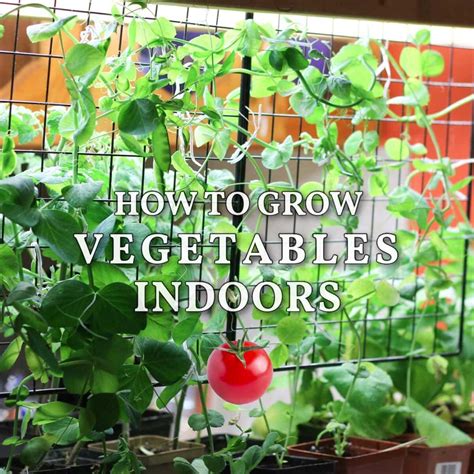The art of growing vegetables inside has become increasingly popular, especially among urban dwellers and those with limited outdoor space. This method, also known as indoor gardening or container gardening, offers numerous benefits, including year-round production, reduced pests and diseases, and improved air quality. However, it also presents some unique challenges that must be addressed to ensure a successful harvest.
One of the primary concerns when growing vegetables inside is providing adequate light. Most vegetables require a significant amount of light to undergo photosynthesis, which is essential for growth and development. Natural light is ideal, but it can be supplemented with artificial lighting, such as LED grow lights or fluorescent lights. The type and intensity of the light will depend on the specific vegetables being grown, as well as the stage of development.
For example, leafy greens like lettuce and kale can thrive in low-light conditions, while tomatoes and peppers require more intense lighting to produce fruit. It’s essential to research the specific lighting requirements for each variety of vegetable to ensure optimal growth.
Another critical factor in indoor vegetable gardening is temperature. Most vegetables prefer daytime temperatures between 65-75°F (18-24°C) and nighttime temperatures around 55-65°F (13-18°C). However, some vegetables, such as tomatoes and eggplants, require warmer temperatures to produce fruit. A thermometer can help monitor the temperature, and adjustments can be made as needed to maintain an optimal environment.
In addition to light and temperature, humidity is also an essential factor in indoor vegetable gardening. Vegetables prefer a relatively high humidity, typically between 40-60%, to prevent water stress and promote healthy growth. This can be achieved using a humidifier or by grouping plants together to create a microclimate.
Soil is another critical component of indoor vegetable gardening. A well-draining potting mix specifically designed for indoor gardening is essential to prevent waterlogged soil and root rot. The soil should also be rich in organic matter, such as compost or worm castings, to provide essential nutrients for plant growth.
When it comes to choosing the right vegetables for indoor gardening, there are several factors to consider. Some vegetables, such as tomatoes and cucumbers, are more challenging to grow indoors due to their large size and high lighting requirements. Others, such as lettuce and herbs, are well-suited for indoor gardening and can thrive in low-light conditions.
Here are some popular vegetables for indoor gardening:
- Leafy greens (lettuce, kale, spinach)
- Herbs (basil, mint, cilantro)
- Cherry tomatoes
- Radishes
- Microgreens (broccoli, cauliflower, arugula)
To get started with indoor vegetable gardening, you’ll need a few basic supplies, including:
- Containers or pots with good drainage
- Potting mix specifically designed for indoor gardening
- Seeds or seedlings
- Fertilizer (optional)
- Pruning tools (optional)
- Support systems (optional)
In terms of specific growing techniques, there are several methods to consider. Hydroponics, for example, involves growing plants in a nutrient-rich solution rather than soil. This method can be highly effective for indoor gardening, as it allows for precise control over nutrient delivery and can reduce water waste.
Another popular method is aeroponics, which involves growing plants in the air, with their roots suspended in a fine mist of nutrient-rich solution. This method is highly efficient and can produce high yields, but it requires a significant investment in equipment and infrastructure.
For those new to indoor vegetable gardening, it’s essential to start small and experiment with different techniques and varieties to find what works best. Here are some tips for beginners:
- Start with easy-to-grow varieties, such as lettuce or herbs
- Use a high-quality potting mix and follow the instructions on the packaging
- Provide adequate light and maintain optimal temperatures
- Water carefully, avoiding overwatering, which can lead to root rot and other issues
- Monitor the plants regularly and take action quickly if any issues arise
What are the best vegetables to grow indoors for beginners?
+Leafy greens, such as lettuce and kale, are excellent choices for beginners, as they are easy to grow and require minimal equipment. Herbs, such as basil and mint, are also well-suited for indoor gardening and can thrive in low-light conditions.
How much light do vegetables need to grow indoors?
+The amount of light required will depend on the specific variety of vegetable, as well as the stage of development. Most vegetables require at least 4-6 hours of direct light per day, but some, such as tomatoes and peppers, require more intense lighting to produce fruit.
What is the ideal temperature for growing vegetables indoors?
+Most vegetables prefer daytime temperatures between 65-75°F (18-24°C) and nighttime temperatures around 55-65°F (13-18°C). However, some vegetables, such as tomatoes and eggplants, require warmer temperatures to produce fruit.
In conclusion, growing vegetables inside can be a highly rewarding and productive experience, offering numerous benefits and opportunities for creativity and experimentation. By understanding the unique challenges and requirements of indoor vegetable gardening, gardeners of all levels can enjoy fresh, healthy produce year-round, regardless of the outdoor environment. Whether you’re a seasoned gardener or just starting out, indoor vegetable gardening is definitely worth exploring.


